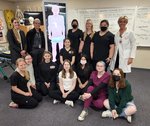


Health science students at Battle Ground High School now have a new state-of-the-art anatomage table.
The equipment allows students to study human anatomy through a large touchscreen computer, while using lifelike models as references.
Tracee Godfrey, the teacher of the advanced health science careers class, said the new dissection table provides students with hands-on experience of being in a cadaver lab without having to leave the high school.
“They actually get to cut and dissect on their own without just observing because to perform in a cadaver lab, you have to take a class, be trained how to do it, and it’s a much more upper-level college program,” Godfrey said.
Students are able to use the high-tech computer to conduct virtual dissections on images of real bodies that were donated for science.
“We go about that knowing that the utmost respect for the human body needs to occur. This is not something we play around with. This is something we learn off of,” Godfrey said. “These humans that gave their life to science have given us an endless amount of knowledge because we can redo it again and again and again.”
Godfrey said the technology allows students to more easily identify certain medical issues. For example, if a patient complains of lower back pain and they grab the side of their spine, the student can figure out the person has a renal issue, which concerns the kidneys.
With a shortage of health care professionals across the country, Godfrey said the technology will give students a better understanding of the service-based industry.
“These are not easy fields (because) we’re dealing with humans and it’s hard to keep people happy and healthy,” Godfrey said.
Godfrey said the new technology has allowed her to “release the students to do more self-discovery.”
“Now when they take their pulse, they can see how hard their heart is working or not working. With young people, they have such a high influence of energy drinks and sugary caffeinated drinks,” Godfrey said. “When they come in and they have a pulse of 120, they can see that their heart is working extra hard, and it’s essentially induced from sugar and caffeine, and that’s not normal. They can then watch the valves open and shut, understanding the flow of the heart.”
When Godfrey started teaching, she used an overhead projector to teach anatomy, so the technology they now use is a far cry from what it used to be.
“I never would have thought in a million years that I would have a cadaver right here, where they could see that it’s true to size and they can blow it up or shrink it, and they can actually see where the body parts are located, versus a mannequin that is fake,” she said.
Besides the anatomage table, students also get to use a bariatric care bed, which was donated from a local hospice center, according to a news release. Godfrey said students who want to become certified nursing assistants can learn to use the equipment.
“Through that, students learn how to make a hospital bed, how to make a hospital bed with a patient in it, how to transfer a patient from a stretcher to a wheelchair, and to a hospital bed,” she said. “They have more time to master the skills and be more confident to really jump up and take advantage and go more in-depth in their learning when they go onto these programs. They have a nursing program at Fire District 5 that we send a lot of them to as well.”
The school’s health science programs have allowed students to be more successful once they graduate from high school, Godfrey said. It teaches students to conduct themselves in a professional manner, and also teaches them to be kind and compassionate as they implement the skills they have learned.